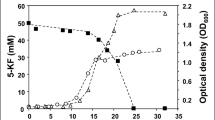Summary
The caecal microflora of Cara rats was incubated in the pH stat with glucose under anaerobic conditions, and the acid production was measured. In the presence of the sweeteners Acesulfame K, Cyclamate and Saccharin, inhibition of the fermentation of glucose was observed with ED50 values of 260, 251, and 140 mM, respectively. The nutritional relevance of these observations is probably slight; an interpretation in terms of bacterial physiology leads to the proposal that the sweeteners may act on glucose transport systems at the bacterial cytomembrane.
Zusammenfassung
Die Mikroflora des Zäkums von Cara-Ratten wurde, unter anaeroben Bedingungen, in einem pH-Stat mit Glucose inkubiert, um die Säurebildung zu messen. In Gegenwart der Süßstoffe Acesulfam K, Cyclamat und Saccharin wurde eine Hemmung der Glucosevergärung mit den ED50-Werten von 260, 251 bzw. 140 mM gefunden. Die ernährungsphysiologische Bedeutung dieser Beobachtung ist wahrscheinlich gering; die Interpretation der Versuche führt im Rahmen der Bakterienphysiologie zu dem Vorschlag, daß die Süßstoffe auf Glucose-Transportsysteme in der bakteriellen Zytomembran wirken.
Similar content being viewed by others
References
Cummings JH (1984) Microbial digestion of complex carbohydrates in man. Proc Nutr Soc 43:35–44
Fritz M, Kasper H, Schrezenmeir J, Siebert G (1985a) Effect of Acarbose on the production of hydrogen and methane and on hormonal parameters in young adults under standardized low-fibre mixed diets. Z Ernährungswiss 24:1–18
Fritz M, Siebert G, Kasper H (1985b) Dose dependence of breath hydrogen and methane in healthy volunteers after ingestion of a commercial disacaride mixture, Palatinit®. Brit J Nutr (in press)
Hungate RE (1984) Microbes of nutritional importance in the alimentary tract. Proc Nutr Soc 43:1–11
Perman JA, Modler S (1982) Glycoproteins as substrates for production of hydrogen and methane by colonic bacterial flora. Gastroenterology 83:388–393
Pfeffer M, Siebert G (1985) Anaerobic drug metabolism by intestinal bacteria — metabolites from Acarbose. Biol Chem (Hoppe-Seyler) in preparation
Renwick AG (1983) The fate of non-nutritive sweeteners in the body. Chapter 7 in Developments in Sweeteners, vol 2 (Grenby TH, Parker KJ, Lindley MG (eds)) Applied Science Publishers, London and New York, pp 179–224
Siebert G, Ziesenitz SC (1985) Acidogenesis in vitro byStreptococcus mutans NCTC 10449 — rapid assay for sugar specifity and inhibitor screening. J Dent Res (submitted)
Wiggins HS (1984) Nutritional value of sugars and related compounds undigested in the small gut. Proc Nutr Soc 43:69–75
Ziesenitz SC, Gross C (1985)Streptococcus mutans NCTC 10449 differentiates sucrose, glucose and fructose in acidogenesis. J Dent Res 64:300
Ziesenitz SC, Siebert G (1985) Non-nutritive Sweeteners as inhibitors of acidogenesis in several oral microorganisms. Caries Res (submitted)
Author information
Authors and Affiliations
Rights and permissions
About this article
Cite this article
Pfeffer, M., Ziesenitz, S.C. & Siebert, G. Acesulfame K, cyclamate and saccharin inhibit the anaerobic fermentation of glucose by intestinal bacteria. Z Ernährungswiss 24, 231–235 (1985). https://doi.org/10.1007/BF02023668
Received:
Published:
Issue Date:
DOI: https://doi.org/10.1007/BF02023668




